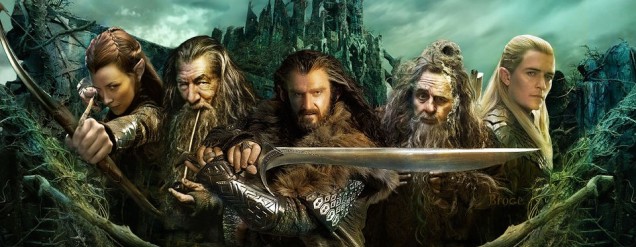This review definitely requires a preface: I am of the opinion of those bibliophiles who believe The Hobbit (originally a single novel by mastermind, J.R.R. Tolkien) never needed to be split into three films. The downward spiral of the progression of the three films did not prove me wrong, though it had its merits at the start.
The Hobbit: An Unexpected Journey (2012)
 The first installment of The Hobbit confirmed some of my initial fears: an unnecessary elven love story to lengthen the otherwise perfect plot, conversational reiterations of just how little Bilbo Baggins fits in, and a bad guy (Azog the Defiler) who only had brief mention in the novel. That said, the first movie did have its merits. The songs were well executed and appropriate to the ballad-style of similar scenes in the novel. Considering there are thirteen dwarves, I think the film did a fair job of giving each a unique character that I could appreciate and use to differentiate one from the next. The film did a wonderful job of showing the softer sides of the dwarves as well as their fierce loyalty (without help of the the oh-so-attractive Kili’s falsified love story with Tauriel). I also feel the first film chose a good place to end.
The first installment of The Hobbit confirmed some of my initial fears: an unnecessary elven love story to lengthen the otherwise perfect plot, conversational reiterations of just how little Bilbo Baggins fits in, and a bad guy (Azog the Defiler) who only had brief mention in the novel. That said, the first movie did have its merits. The songs were well executed and appropriate to the ballad-style of similar scenes in the novel. Considering there are thirteen dwarves, I think the film did a fair job of giving each a unique character that I could appreciate and use to differentiate one from the next. The film did a wonderful job of showing the softer sides of the dwarves as well as their fierce loyalty (without help of the the oh-so-attractive Kili’s falsified love story with Tauriel). I also feel the first film chose a good place to end.
Individual Rating: 4/5
(with a touch of unfounded hope)
The Hobbit: The Desolation of Smaug (2013)

The second installment of The Hobbit distracted a book-loving viewer from judging it too harshly by including flashy elements that really were rather remarkable. First, there’s the barrel scene. Wow. It’s fun and cool and totally indicative of the resourcefulness of both hobbits and dwarves. Then there’s the visual wonderment of the dragon, Smaug. CGI at its finest and the enhanced basses of Benedict Cumberbatch’s sonorous and threatening voice, Smaug steals the hearts of audiences everywhere, bibliophiles or not. But the just-for-TV manufactured love story drags the entire plot down with prolonged gazes of pitifully unrequited love that leave viewers wondering why Tauriel has such a hard time simply accepting Legolas…..wait…Legolas? What’s he doing in this movie? He was never explicitly mentioned in the novel version, let alone given any backstory. This wouldn’t have troubled audiences if the film had given him an intriguing history, but a silly love triangle and mommy-issues certainly didn’t fit the bill.
Individual Rating: 3.5/5
For spectacular effects and stinky screenwriting.
The Hobbit: The Battle of the Five Armies (2014)

SPOILER ALERT: After killing Smaug (with little climactic tension) within the first ten minutes of the third installment (why wasn’t that done in place of the love scenes in the second movie?), the plot is free to pursue this conglomeration of five armies in an epic battle to rival all epic battles.
Or so you thought.
First, from the perspective of someone who might not have read the books, it is completely ambiguous who the five individual armies actually are. Good luck figuring that one out. (In the book it was: Goblins/Wargs versus Men, Elves, Dwarves, and Eagles.) You probably couldn’t guess the five armies in the film even if you HAD read the novel simply because there was no battle. Brief clips of warfare that could have been outtakes from The Lord of the Rings film trilogy were scattered amidst excessive scenes of longing (Kili and Tauriel), video-game jumping moves (Legolas), and a serious lack of Zombieland double-tapping on the part of Thorin (who foolishly expects Azog to be “dead in the water”).
The CGI effects that improved the second film so much were completely overdone in this film. This, combined with horrendously cliché lines (“If this is love, why does it hurt so much?”–Dramatic response: “Because it was real.”) doesn’t even give the viewer a chance to suspend disbelief in order to immerse themselves in the “action.”

Reblogged this on My Blog News.
LikeLike